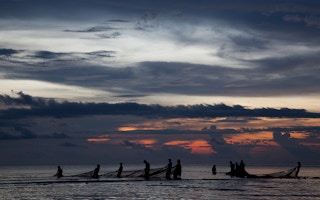Oceans leaders gathered this week in Malta for the annual Our Ocean conference, where major commitments about the future of ocean conservation and sustainability were expected from heads of state, ministers, CEOs and others.
With representatives from Conservation International at the event, here’s a look at five key issues being discussed at the conference that have major implications for the health of the seas.
- A new way to conserve the ocean: Get business on board.
You’ve heard of financial capital and human capital. But natural capital?
Companies that rely on the ocean’s “natural capital” — that is, the benefits that the ocean provides, whether for fishing, shipping, climate regulation, etc. — face risks to their business models if those benefits change or disappear. (Read more about natural capital here.)
To that end, the Natural Capital Coalition and Conservation International (CI) are teaming up to produce an oceans-specific framework to help businesses evaluate their impacts and dependencies on the ocean.
“The private sector will contribute more powerfully to solving ocean health problems if they understand and believe that this is in their own best interests,” said Keith Lawrence, senior director of CI’s Seascapes program. “By highlighting how businesses depend on healthy oceans, this new framework will help them take the necessary steps to protect oceans, in the interests of protecting their bottom line.”
- It pays to invest in ocean conservation.
Conservation-oriented investments have yet to significantly benefit from private-sector finance. Why? Social enterprises, especially those in developing countries, often lack the track record and technical or operational capacity that most investors require. (Read more about some of these issues here.)
“In most of the developing world, conservation right now is not a viable economic option,” CI’s Agustin Silvani told Human Nature last year. “It usually doesn’t pay; there are no cash flows associated with it. We need to fill this finance gap.”
Enter the Blue Accelerator Fund, which aims to fill the gap between investors and investment-ready enterprise. The fund will support fishery, aquaculture (fish farming) and ocean-based tourism, by providing bridge financing and linking enterprises with investors, technical expertise and markets for sustainable products and services.
- The most important ecosystem on the planet just got some powerful new allies.
Hectare for hectare, mangroves — coastal forest ecosystems found in the tropics — store more carbon than any ecosystem on Earth. At the same time, they buffer coastal communities from storm surges while providing a veritable nursery for countless marine species crucial to people’s food security and livelihoods. (Read more about mangroves here and here.)
Yet fully half of the world’s mangroves have been lost to development, and they continue to disappear fast.
Now, a new alliance is taking action to reverse their fortunes. The Global Mangrove Alliance — a partnership of CI, The Nature Conservancy, WWF, the International Union for Conservation of Nature, and Wetlands International — aims to increase the global area of mangrove habitat 20 percent over its current extent by the year 2030.
- To protect countries on the front lines of climate change, mix ‘green’ with ‘gray.’
Coastal communities facing rising seas and stronger storms need help adapting to the effects of climate change. A mix of “green” infrastructure (mangroves, for example) and “gray” infrastructure (such as sea walls) is an effective — and cost-effective — way to protect coastal communities.
A partnership between CI and Bechtel Corp. will demonstrate how to integrate these “green-gray” solutions across the developing world, starting in the Visayas region of the central Philippines, devastated by Typhoon Haiyan in 2013. The project will provide coastal protection from typhoons, sustainable livelihoods for coastal communities, and critical habitat for marine life in one of the highest diversity marine regions on Earth.
- Stop illegal fishing, using eyes in the sky.
Illegal fishing is rampant in Costa Rica, with disastrous effects on the country’s economy and unique marine ecosystems. With nearly 600,000 square kilometers (373,000 square miles) of ocean and no military, stopping illegal activity on the ocean is no easy feat.
But you can’t hide from eyes in the sky. CI, working with the government and OceanMind, a non-profit dedicated to fishing sustainability, generated a baseline picture of fishing in Costa Rican waters. Monitoring more than 5,000 vessels with satellite technology, the partners were able to isolate more than 100 potentially illegal activities.
In the next year, CI will work with the Costa Rican government to follow up on potential cases of illegal fishing and share the results with other countries in the region, including Ecuador, where satellite technology was used to bust a fleet of Chinese vessels fishing illegally off the Galápagos Islands in August.
Bruno Vander Velde is CI’s editorial director.
This piece was published with permission from Conservation International.











